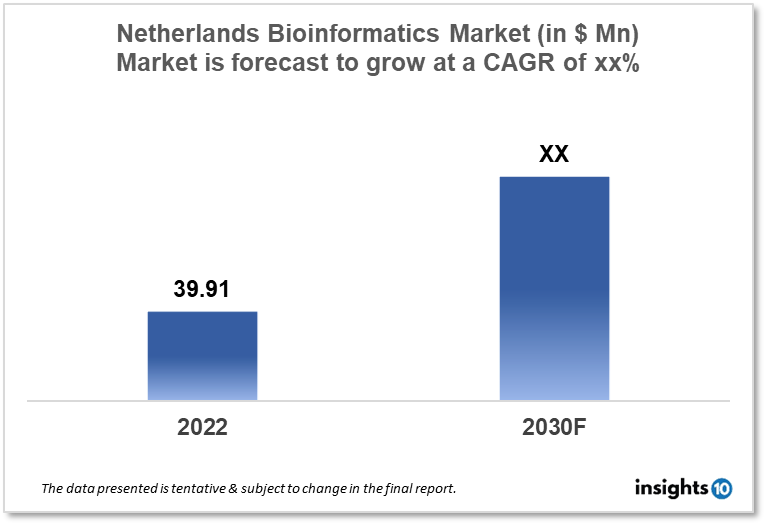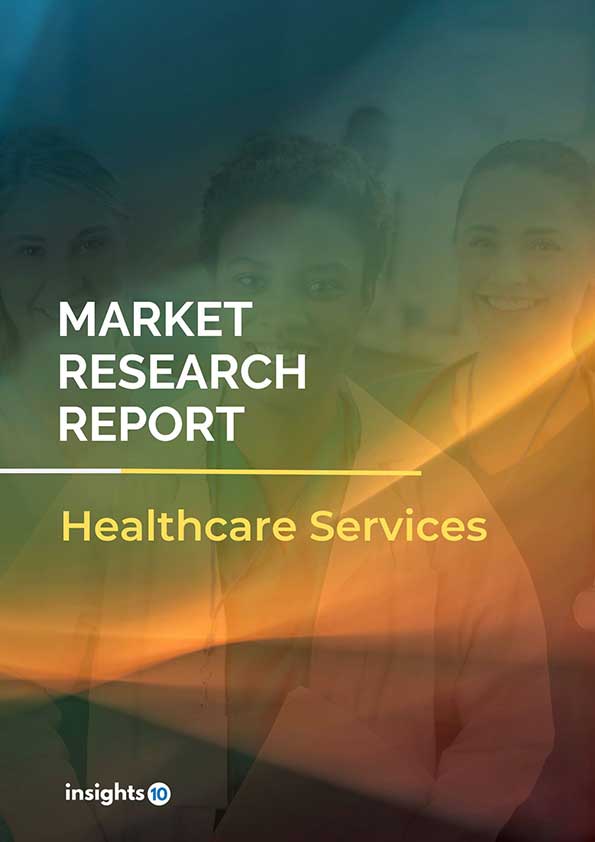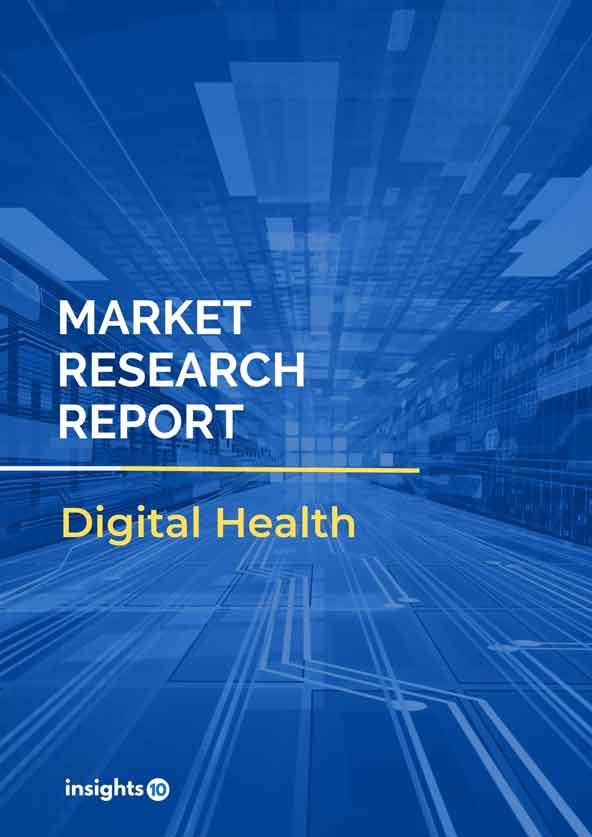Netherlands Bioinformatics Market Analysis
Netherlands's Bioinformatics market is projected to grow from $39.91 Mn in 2022 to $xx Mn by 2030, registering a CAGR of xx% during the forecast period of 2022-30. The main factors driving the growth would be strong research and development capabilities, a high level of collaborations and partnerships, and government support. The market is segmented by technology and by application. Some of the major players include Microbial Bioinformatics (NLD), Enpicom (NLD), Crown Bioscience, Illumina, Agilent Technologies, IBM Life Sciences, and Qiagen.
Buy Now

Netherlands Bioinformatics Market Executive Summary
Netherlands's Bioinformatics market is projected to grow from $39.91 Mn in 2022 to $xx Mn by 2030, registering a CAGR of xx% during the forecast period of 2022-30. In 2019, health spending in the Netherlands as a percentage of GDP reached 10.13% or $5,335 per person from 10.03% or $$5,333 in 2018. The Netherlands spends more per person on health than the average EU country, with a sizable portion going into long-term care.
Bioinformatics is a scientific area that integrates biology and information technology. Bioinformatics uses a variety of approaches, such as data management, data mining, data warehousing, and data generation. Bioinformatics software and tools are used as integrated solutions to provide statistical techniques and data processing algorithms for applications including next-generation sequencing, modeling of genomic and proteomic structure, and three-dimensional drug discovery. The Netherlands bioinformatics market is expanding, with a concentration on fields like genetics, proteomics, and drug development.

Market Dynamics
Market Growth Drivers
The Netherlands bioinformatics market is expected to be driven by factors such as strong research and development capabilities, high level of collaborations and partnerships, and government support. The Netherlands Bioinformatics Centre (NBIC), a government-funded institution, managed all academic bioinformatics research in the country. NBIC offers assistance, education, and research-related initiatives which will help the market to grow.
Market Restraints
Lack of standardization in the field and the high cost of developing and implementing bioinformatics solutions can limit the growth of the industry, especially for SMEs (Small and Medium Enterprises).
Competitive Landscape
Key Players
- Microbial Bioinformatics (NLD)
- Enpicom (NLD)
- Base Clear (NLD)
- Illumina
- Agilent Technologies
- IBM Life Sciences
- Qiagen
Healthcare Policies and Regulatory Landscape
The healthcare system in the Netherlands is highly advanced. Government initiatives to encourage business and academic cooperation as well as financing for research and development have all been put in place to help the development of the bioinformatics sector. The Netherlands Healthcare Inspectorate (IGZ) is the primary governing body for healthcare services in the country. The IGZ is in charge of ensuring that healthcare practitioners give patients high-quality care and that they do so in accordance with local, national, and international laws and standards.
Additionally, The Netherlands adheres to the rules established by the European Union (EU) and the European Medicines Agency (EMA) for the development and approval of all medical products. This covers rules for data security and privacy as well as recommendations for applying artificial intelligence to healthcare.
Reimbursement Scenario
The Dutch Healthcare Authority (NZa) and the Ministry of Health, Welfare, and Sport (VWS) set reimbursement guidelines in the country. Which medical supplies and services qualify for payment under the Dutch healthcare insurance system is determined by these organizations.
A clinical evaluation of the product or service, a cost-effectiveness analysis, and a decision by the NZa or VWS on reimbursement are often included in the reimbursement process. The availability of alternative therapies, the cost-effectiveness of the product or service, and its clinical efficacy are all factors taken into account when determining whether to pay a provider.
Bioinformatics services and products are often reimbursed based on their efficiency and cost-effectiveness, with a focus on patient clinical results. In order to guarantee that patients have access to the most recent and efficient therapies, payment policies are routinely evaluated and revised.
1. Executive Summary
1.1 Service Overview
1.2 Global Scenario
1.3 Country Overview
1.4 Healthcare Scenario in Country
1.5 Healthcare Services Market in Country
1.6 Recent Developments in the Country
2. Market Size and Forecasting
2.1 Market Size (With Excel and Methodology)
2.2 Market Segmentation (Check all Segments in Segmentation Section)
3. Market Dynamics
3.1 Market Drivers
3.2 Market Restraints
4. Competitive Landscape
4.1 Major Market Share
4.2 Key Company Profile (Check all Companies in the Summary Section)
4.2.1 Company
4.2.1.1 Overview
4.2.1.2 Product Applications and Services
4.2.1.3 Recent Developments
4.2.1.4 Partnerships Ecosystem
4.2.1.5 Financials (Based on Availability)
5. Reimbursement Scenario
5.1 Reimbursement Regulation
5.2 Reimbursement Process for Services
5.3 Reimbursement Process for Treatment
6. Methodology and Scope
Bioinformatics Market Segmentation
By Technology (Revenue, USD Billion):
- Knowledge Management Tools
- Bioinformatics Platforms
- Bioinformatics Services
By Application (Revenue, USD Billion):
- Metabolomics
- Molecular phylogenetics
- Transcriptomics
- Chemoinformatic & drug design
- Genomics
- Others
Insights10 will provide you with the reports within 10 key parameters which are:
- Market Overview
- Market Growth Drivers & Restraints
- Epidemiology of Disease Type
- Market Segmentation
- Market Share
- Competitive Landscape
- Key Company Profiles
- Healthcare Policies & Regulatory Framework
- Reimbursement Scenario
- Factors Driving Future Growth
Based on our many years of experience, we believe that these are the parameters that are critical to decision-making for business stakeholders. Our focused approach to developing reports focused on 10 key parameters, enabled us to arrive at the name “Insights10”.

Stage I: Market Data Collection
Primary Interviews: We have developed a network of experts, freelancers, and researchers across countries through which we engage with local experts to gather key data points and assumptions about each market. We also engage regularly with some of the best market research agencies such as Atheneum, GuidePoint, GLG, etc. to conduct surveys and interviews, and build intelligence. We have language translators as a part of our team, who between them can cover 30+ languages allowing us to extract better local insights.
Secondary Data Collection: We have developed strong expertise and experience in secondary data collection methods for developing unique data sets and research material. We gather data from multiple reliable sources to maintain a high level of accuracy and consistency. The market data is analyzed and forecasted using appropriate statistical and coherent models. The report offers an overall analysis of the market size, growth, and market share as well as a segment-level analysis of the specific market. Our report includes precise, to-the-point information related to the overall market, competition, growth drivers, challenges, regulatory updates, and competition.
Data Sources: We have access to multiple highly reliable free and subscription data sources. We have many years of experience to understand which sources are more dependable for what and which to prefer for the reliable and latest information. The key sources of information include the following, but are not limited to:

Stage II: Market Data Analysis and Statistical Model
Market Trends: We generally look at macro parameters and micro indicators. The macro parameters include changes in government policies, demand and supply of the market, government intervention programs, and major market share. The micro indicators are GDP growth, market size, market volume, etc. We also understand nuances specific to each country like the US, Canada, India, Germany, etc., and have worked across 60+ countries and hence not only understand global trends but how these differ by country, how payment models, market structure, cultural parameters, etc. differ in each country.
Market Sizing and Analysis: Our expert data analytics team has created various market forecast models by employing the top-down approach i.e. starting with the large overall market and segmenting different areas and the bottom-up approach i.e. starting with population and epidemiology and rolling up based on spend, etc., estimating the size of the market, and distributing among the geographic and/or product segments.
The top-down approach is mainly used for new product forecasting and the bottom-up approach is used for demand estimation of any product for different countries summed up to form the total market. We are able to round off insights and build stronger forecasts because we always do both these methods and triangulate the final numbers.
The study on the market covers the analysis of the leading geographies such as Asia-Pacific, Africa, Europe, Middle East, North America, and Latin America for the period of 2022 to 2030. The qualitative analysis covers the industry landscape and trends, market opportunities, competitive landscape, and policy and regulatory scenario, and the quantitative analysis covers different market estimates and forecasts.
Data Triangulation & Validation:
Data triangulation of various sources and results of the research are carried out by benchmarking with reliable sources such as industry statistics, statistical databases, and company-level averages, etc.
We make sure to finalize the numbers in alignment with the market research. Firstly, our internal experts ensure thorough validation and checking to ensure accurate and precise analysis and then validation is also done using a multiple-data analysis model. Two-level validation is done and entails the finalization of the report scope and the way of representation pattern.
(1).png)
Stage III: Interpretation and Presentation
Analysis & Interpretation: The information gathered is then analyzed and synthesized. The second series of interviews are done if necessary to check and validate. The future opportunities are analyzed by understanding product commercialization and many other factors. It also comprises the analysis of data discrepancies observed across various data sources. Information procured from secondary and primary results is then, interpreted by considering the following parameters: (a partial list)
- Establishing market drivers and trends
- Analyzing the regulatory landscape to understand future growth
- Market Segment based analysis to obtain revenue/volume
- Analyzing current needs and determining penetration to estimate the market
Insights: Our reports deliver actionable insights backed with supporting facts and figures to assist you in achieving exemplary growth. Our in-depth analyses are interspersed with relevant insights and statistics to offer an executive-level view of a given market. The description helps in correlating many minor factors affecting the market and their impact on the different segments within the market.
Data curated from the analysis and interpretation are drawn to portray all in one consolidated report.
Presentation & Reporting: The market research report is presented in different forms such as charts by using a scientific approach for easy understanding. Historic, current, and future analysis is provided for each market in terms of both value and volume. The size of the market is interpreted in the US Dollar value and the respective unit, based on the product, for volume consumption.
The foreign exchange rates are calculated on the respective dates and for the respective regions covered in the study.
To request a free sample copy of this report, please complete the form below.
We value your inquiry and offer free customization with every report to fulfil your exact research needs.
This report addresses
- Intelligent insights to take informed business decisions
- Qualitative, acute and result oriented market analysis
- Market size and forecasts from 2022 to 2030
- Opportunities for expansion and in-depth market analysis
- Segmentation and regional revenue forecasts
- Analysis of the market share and competitive landscape
- Strategic Recommendations to chart future course of action
- Comprehensive Market Research Report in PDF and PPT formats
Need more?
- Ask our analyst how this study was put together to learn more
- Discuss additional requirements as part of the free customisation
- Add more countries or regions to the scope
- Get answers to specific business questions
- Develop the business case to launch the product
- Find out how this report may influence your business revenue



